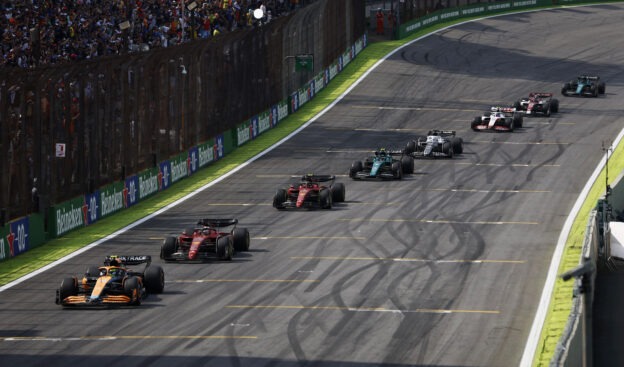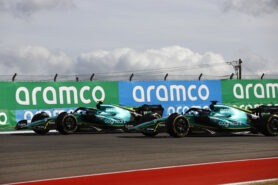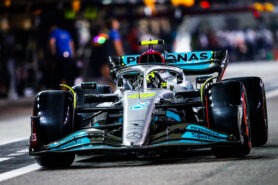The Business of F1 Racing: Sponsorships, TV Rights and more

| Table of Contents |
| 1. Sponsorships |
| 2. F1 TV Rights |
| 3. Other Revenue streams |
| 4. Challenges and Future |
| 5. Conclusion |
Formula 1 racing, also known as F1, is the highest class of single-seater auto racing. It has been around for over 70 years, starting in 1950 and it is considered to be the pinnacle of motorsports. The sport is known for its speed, technology, and competition between the best drivers in the world.
But, there is more to Formula 1 than just the thrill of racing. In fact, F1 is a multi-billion dollar industry, generating revenue from a variety of sources, such as sponsorships, television rights, and other business ventures.
The significance of Formula 1 racing is global, with races taking place in countries all over the world, and millions of fans tuning in to watch the action. The teams are based in different countries and they are owned by billionaires and large corporations and they have huge budgets, spend on R&D, and employ hundreds of engineers and mechanics.
Understanding the business side of Formula 1 racing is crucial for understanding the sport's sustainability and growth. By understanding the different revenue streams that keep the sport running, fans can gain a deeper appreciation for the financial investments that go into making each race possible. Additionally, knowledge of the business side of the sport can give insight into the future developments and changes that may shape the sport.
In this article, we will be delving deeper into the business of Formula 1 racing, examining the key revenue streams, such as sponsorships, TV rights, and other business ventures that keep the sport running. With this information, fans will be able to gain a better understanding of the sport, its history and its future.
1. Sponsorships
Sponsorships are a major revenue stream for Formula 1 teams and the sport as a whole. They are a form of advertising in which a company provides financial support to a team or the sport in exchange for exposure through branding and advertising on the cars, team uniforms, and trackside signage.
In the context of Formula 1 racing, sponsorships are used to cover the high costs of running a team, such as building and maintaining cars, paying for travel and lodging for the team, and supporting the team's research and development efforts.
There are many major sponsors in the sport, such as tobacco companies, luxury car manufacturers, and oil companies. These companies see Formula 1 as a way to gain exposure and promote their products to a global audience.
For example, Mercedes AMG Petronas team is sponsored by Petronas (Malaysian Oil and Gas Company), Mobil 1 and INEOS (chemical company) among others.
The impact of sponsorships on teams and the sport as a whole is huge. For teams, sponsorships provide the necessary financial resources to compete at the highest level. This allows teams to invest in the technology and personnel necessary to design and build competitive cars. For the sport as a whole, sponsorships help to cover the costs of organising and promoting races, as well as funding research and development efforts aimed at improving safety and reducing costs.
Additionally, sponsorships play a major role in the sport's branding and image. Sponsors are often household names and their branding helps to promote Formula 1 racing to a wider audience. For example, Formula 1 has a huge fan base in the Middle East and North Africa because one of the leading team is sponsored by Etihad Airways, the national airline of the United Arab Emirates.
2. F1 TV Rights
Television rights are another major revenue stream for Formula 1 racing. These rights give media companies the ability to broadcast live or recorded races on television or streaming platforms.
In the past, television rights were sold on a race-by-race basis, with each race having its own broadcaster. However, in the current model, the rights are sold on a season-by-season basis to one or more broadcasters, who then have the exclusive right to show the entire season of F1 races to the audiences in a particular territory.

F1 TV camera at Circuit de Barcelona-Catalunya, in Montmelo, Barcelona, Spain - Photo Florent Gooden / DPPI
The history of TV rights in Formula 1 racing has seen many changes. In the early days, the sport was largely covered by terrestrial broadcasters, with a small number of races shown on cable or pay-per-view channels. However, as the sport has grown in popularity, more and more races have been shown on pay-TV channels. In recent years, streaming services have started to get involved in broadcasting Formula 1, with some races being streamed exclusively online.
Currently, the rights to broadcast Formula 1 races are held by a combination of terrestrial, cable, and streaming platforms. The distribution of the revenues generated from these rights is usually shared among the teams and the sport's governing body.
For example, in United States, the rights are held by NBC Sports Group and they broadcast all the F1 race on cable. In United Kingdom, the rights are split between the BBC and Sky Sports, where the BBC covers certain number of races on free-to-air, while the rest of the races are covered by pay-TV channel, Sky Sports.
TV rights are also a key factor in determining the sport's visibility, as it allows the sport to reach a large audience and generate significant revenue. It also acts as an important factor for the teams to attract new sponsors, as teams are able to showcase their branding on national and international level.
3. Other Revenue streams
Sponsorships and television rights are not the only revenue streams for Formula 1 racing. The sport generates revenue from a variety of other sources as well.
One major source of revenue is race hosting fees. Hosting a Formula 1 race is a costly undertaking, and the host country or organisation will often pay a fee to the sport's governing body, in order to host a race. These fees can be substantial, and they are used to cover the costs of organising and promoting the race, as well as investing in safety and infrastructure upgrades.
Another source of revenue is merchandise sales. Formula 1 teams, as well as the sport as a whole, sell a wide range of merchandise, such as clothing, die-cast models, and other memorabilia. These sales can generate significant revenue, and also help to promote the sport and the teams.

Sebastian Vettel leads his Aston Martin teammate Lance Stroll, Circuit of the Americas, 2022 USA F1 GP
Track-side advertising is another source of revenue. Advertisers pay to have their branding placed on billboards and other signage around the track. This provides exposure to a large and captive audience, as well as providing a source of revenue for the sport.
When comparing Formula 1's revenue streams to other major sports, it's worth noting that the sport generates a significant amount of revenue from international sources, such as hosting fees and merchandise sales. Formula 1 is also unique in that it is a global sport, with races taking place in multiple countries, which generates a lot of revenue from international audiences. Additionally, the sport has a high-end, exclusive image, and attracts a large number of high-paying sponsors from luxury and technology sectors. This is different from other sports like American Football, Basketball or Football, which generate most of their revenue domestically from domestic sponsors and TV rights.
4. Challenges and Future
Despite its success as a global sport, Formula 1 racing faces several challenges when it comes to its business model. One of the biggest challenges is declining television viewership. In recent years, TV ratings for Formula 1 races have been decreasing, which can have a negative impact on revenues generated from television rights. There are several reasons for this decline, such as the loss of free-to-air coverage, changes in audience habits with the increasing popularity of streaming, and the cost of pay-TV subscriptions.

Daniil Kvyat of Russia and Infiniti Red Bull Racing sets a time in a simulator during previews to the Formula One Grand Prix of Russia at Sochi Autodrom on October 8, 2015
Another challenge facing Formula 1 is the need for cost control. Running a Formula 1 team is extremely expensive, and the cost of competing in the sport has risen dramatically in recent years. This has led to a need for cost control measures, such as budget caps, in order to ensure the financial sustainability of the sport.
In order to address these challenges, Formula 1 is considering new ways to generate revenue and promote the sport to a wider audience. One potential development is the use of Over-The-Top (OTT) platforms. By streaming races live on these platforms, Formula 1 could reach a larger audience and generate additional revenue from streaming subscriptions.
Another potential development is the growth of Esports. Formula 1 has already launched its own Esports series, where players can compete in virtual races using the official Formula 1 game. This allows Formula 1 to reach a younger audience and promote the sport to a new generation of fans, while also generating additional revenue from sponsorships and merchandise sales.
Formula 1 is also considering other ways to promote the sport, such as through the use of social media and by organizing fan engagement events.
Conclusion
Formula 1 racing is more than just a sport, it is a multi-billion dollar industry that generates revenue from a variety of sources, such as sponsorships, television rights, and other business ventures. Understanding the business side of Formula 1 racing is crucial for understanding the sport's sustainability and growth.
Throughout this article, we have examined the key revenue streams of Formula 1 racing, including sponsorships, TV rights, and other revenue streams like race hosting fees, merchandise sales and trackside advertising. We have also seen how the business of F1 differs from other major sports, by its global reach and high-end, exclusive image.
While the sport is successful, it is not without its challenges. Declining TV viewership and the need for cost control are among the challenges facing Formula 1's business model. However, by embracing new technologies and fan engagement strategies, such as OTT platforms and Esports, Formula 1 can address these challenges and continue to grow as a global sport.
In conclusion, Formula 1 racing is a hugely successful global sport with a unique and specific business model. Understanding the business side of the sport is crucial to understanding its sustainability and growth and the challenges and opportunities it may face in the future.
✅ Check out more posts with related topics:















Conclusion...!!, a lot of shite in this article in the UK it's shared between C4 and Sky and not the BBC and Sky
Well my word, you learn something new every day. If only Lewis would retire, maybe viewing figures would plummet, I mean rocket.
Latest rumour in the paddock is that Elon Musk is buying Liberty, the FIA, Andretti and Cadillac and the new team will be called Twitter with Andretti and Tesla, powered by Cadillac universal nano technology. They are looking for suggestions for abbreviations, big prize from Leopold for the best suggestions , please apply to Stroppyfly for entries.
✅ Checkout the latest 50 F1 Fans comments.